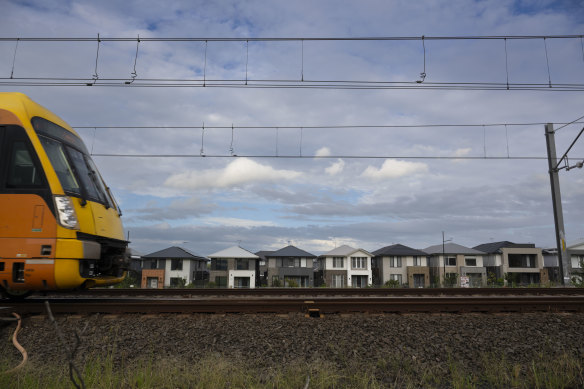This was published 4 months ago
Opinion
High-speed trains are no silver bullet, but they could help shift house prices
Millie Muroi
Economics WriterThe first time my 97-year-old granddad took a bullet train in Japan was during the 1970s. He was supposed to be shaving 23 minutes off what would otherwise have been a half-hour drive to a business meeting, but that seven-minute trip ended up taking him more than a day. Why? Because he didn’t realise how quickly he would be disembarking and ended up nearly 200 kilometres away from his intended destination.

Millie Muroi at a bullet train station in Japan.
Nearly five decades later, I’ve taken dozens of bullet trains to visit relatives in different parts of the country. Reaching speeds of up to 320km/h, these trains still fill me with awe.
High-speed rail has been written off by critics in Australia for decades, mostly owing to the country’s smaller population and density compared to Japan – and the seemingly huge cost of building the infrastructure required. But with Australian property prices chugging along aggressively and NIMBYs putting the brakes on housing density, there’s an ever-growing need to encourage decentralisation.
While satellite cities such as Parramatta in greater western Sydney and Dandenong in south-eastern Melbourne are gaining traction, there’s still a strong need for people to be connected to our country’s major business districts or inner suburbs, whether for work or leisure.
Australia’s population growth is expected to slow to 1.1 per cent over the next 40 years, from 1.4 per cent for the past 40 years. But that’s still 13 million additional people who need to live and get around, especially in and around the major cities.
When we think about high-speed rail, we often think big: a bullet train network connecting Sydney, Melbourne and Brisbane, for example. But it might pay to focus on smaller distances and trains that go faster than our existing ones, even if they don’t quite hit bullet train speeds.

Slow journey times are a deterrent to commuting.Credit: SMH
Currently, the train from Wollongong to Sydney takes about 90 minutes, Newcastle to Sydney 150 minutes, and Geelong to Melbourne about 75 minutes. In 2022, the former NSW government released a proposed fast-rail map showing a route that would halve the journey time from Wollongong to Sydney by rail to 45 minutes. That followed federal government support in 2019 for a fast-rail scheme slashing the Geelong to Melbourne commute to about 50 minutes.
But these projects seem to have been shelved. And shamefully, despite hundreds of millions of taxpayer dollars spent on feasibility studies, the key findings of a review into fast-rail options for NSW have been kept under wraps by both the previous and current state governments.
That review, led by British rail expert Professor Andrew McNaughton, who was a technical adviser to the UK’s HS2 rail scheme and now chairs the UK’s Network Rail High Speed, has never been released. But McNaughton has said his research showed that linking Newcastle, Wollongong and Sydney by fast rail would “change the face of NSW”, cutting the Newcastle to Sydney commute to about an hour.
While the Grattan Institute has shot down the case for Japanese-style bullet trains in Australia, they are less opposed to the idea of upgrading some existing rail lines. They point out that bullet trains, which can run at speeds above 250km/h (while likely to reduce emissions from flights between Melbourne and Sydney, for example), would be enormously emissions-intensive to build and too costly given Australia’s relatively small population. Their estimate in 2020 was that it would cost taxpayers across the country about $10,000 each.
But upgrades to existing infrastructure, including electrifying tracks and removing bends and inclines, could enable some of our existing trains to travel at speeds of up to 200km/h. That’s about twice as fast as most regional trains in Australia. At this speed, the trains would be “faster rail”: not quite as cool as “high-speed” rail, but enough to halve travel times to some of our regional cities.
In 2020, about 25,000 Sydney workers commuted daily from the Central Coast, 19,000 from Wollongong, and 14,000 Melbourne workers commuted from Geelong. A faster rail network would not only benefit these people but also make living in these regional centres more realistic, especially for those struggling with housing affordability in inner-city locations but needing to commute there for work.
The Grattan Institute points out that relaxing zoning restrictions is key to improving housing affordability, with zoning regulations making up about 42 per cent of the cost of a home in Sydney and Melbourne. But with little movement on that front, we need to think about other ways to ease pressure on capital city housing prices. By improving transport to areas outside the inner suburbs, we can help those on lower incomes who want more affordable housing while still keeping their capital city job.
If NIMBYs are unwilling to accommodate density, they need to be prepared to foot the bill for better transport.
We also need more (and faster) transport options connecting our outer suburbs (the likes of Parramatta and Dandenong) to our city centres and inner suburbs. This makes life easier for the large number of people living in the outer suburbs, reduces Australia’s astonishing car dependency and makes it easier for those commuting in from even further out in regional cities. The Sydney Metro West project is a good start.
While high-speed rail between the capital cities could be an option down the line, we should focus on smaller segments, such as Wollongong to Sydney and Geelong to Melbourne, and speed up our existing train lines to a “faster rail” standard.
This would come with added benefits on top of more affordable housing: reduced commute times, less road congestion and lower emissions.
Any effort to meaningfully upgrade our rail network will be expensive. But unless we can increase housing density in well-located suburbs, improving our public transport is the best alternative as our growing population gets pushed further out from our city centres.
In a 2021 study examining the impact of bullet trains in Japan, the presence of a bullet train line was enough to keep housing prices lower than they would have been without the line. “The [bullet train] helped Japanese cities to decentralise, which in return reduced prices in cities from what they otherwise might have been,” the study found.
The Albanese government invested $500 million in high-speed rail last year, but it is far from the first government in Australia’s history to try its hand at getting quicker trains on track. So far, every attempt has simply led to reports, business cases, and reviews that either never see the light of day or become outdated.
I’m not holding my breath for high-speed rail to come through in my lifetime, and it’s not necessarily the most efficient use of money.
But if we can speed up some of our existing infrastructure and make outer suburbs and regional city housing a realistic option for city workers on lower incomes, I will see the light at the end of the tunnel. I wish I could worry about missing my stop because of the sheer speed of our trains. Unlikely. But I can settle with affordable housing and a decent commute to work.
Millie Muroi is a business reporter.
The Business Briefing newsletter delivers major stories, exclusive coverage and expert opinion. Sign up to get it every weekday morning.